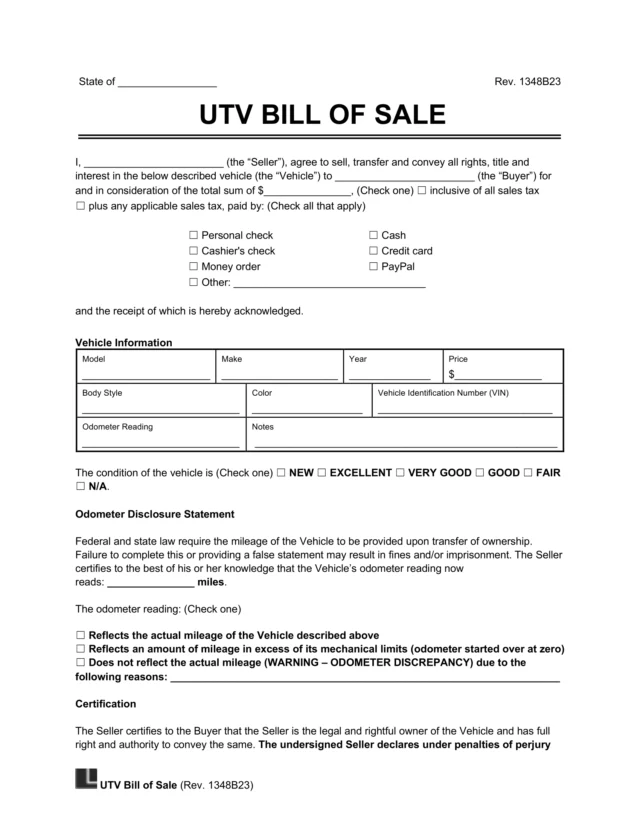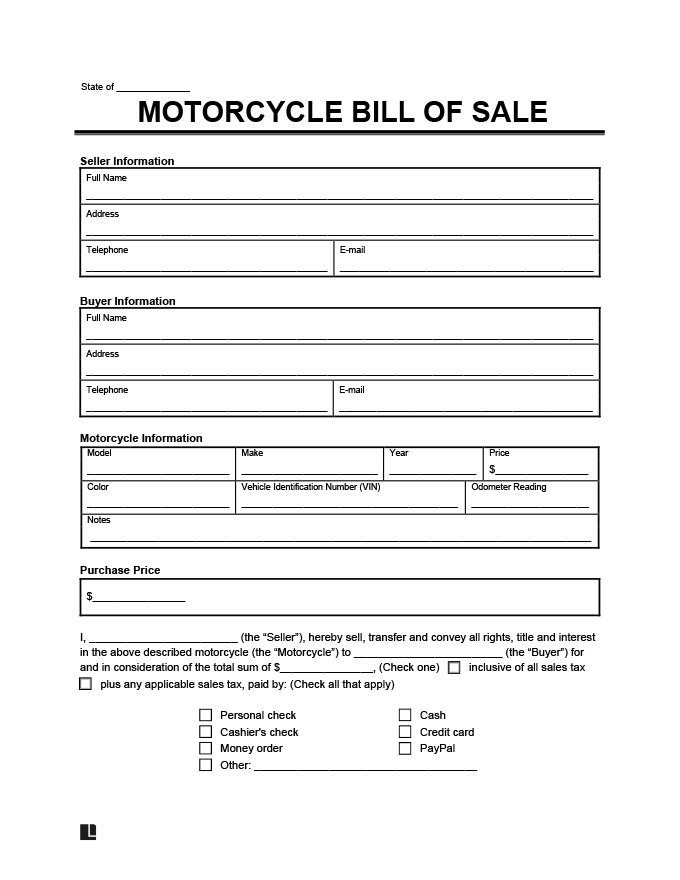Motorcycle Bill of Sale – By State
Every state has its own motorcycle bill of sale rules. Find yours below so you include the right details and meet legal requirements.
- Alabama
- Alaska
- Arizona
- Arkansas
- California
- Colorado
- Connecticut
- Delaware
- District of Columbia
- Florida
- Georgia
- Hawaii
- Idaho
- Illinois
- Indiana
- Iowa
- Kansas
- Kentucky
- Louisiana
- Maine
- Maryland
- Massachusetts
- Michigan
- Minnesota
- Mississippi
- Missouri
- Montana
- Nebraska
- Nevada
- New Hampshire
- New Jersey
- New Mexico
- New York
- North Carolina
- North Dakota
- Ohio
- Oklahoma
- Oregon
- Pennsylvania
- Rhode Island
- South Carolina
- South Dakota
- Tennessee
- Texas
- Utah
- Vermont
- Virginia
- Washington
- West Virginia
- Wisconsin
- Wyoming
What Is a Motorcycle Bill of Sale?
A motorcycle bill of sale is a written record of the deal between the buyer and seller. It confirms the transfer of ownership and includes key bike details such as the VIN, engine size in cubic centimeters (cc), mileage, frame number, and any modifications.
DMV offices often rely on this information during registration and title transfers. A complete and accurate motorcycle bill of sale helps the new owner move through the process without delays.
When to Use a Motorcycle Bill of Sale
Use a motorcycle bill of sale any time you’re buying or selling a motorcycle in a private deal. It works for used motorcycles, older models, project bikes, and barn finds. Sellers use it to show they no longer own the motorcycle. Buyers rely on it when the motorcycle has:
- Modifications (mods) or aftermarket parts
- A custom frame or rebuilt status
- Dirt-bike or dual-sport conversions
Some states even require a bill of sale on top of the title, especially when the motorcycle has custom work or an unclear history.
How to Get a Motorcycle Title With a Bill of Sale
If the seller lost the title, some states let you apply for a new one with a signed bill of sale. Bring your ID, the VIN, and the motorcycle’s current odometer reading to the DMV. Requirements vary, so review your state’s rules first. If everything checks out, the DMV issues a new motorcycle title and charges the standard fees.
Can You Register a Motorcycle With a Bill of Sale?
Sometimes. It depends on whether your state requires a title for that specific motorcycle. For example:
- States like Maine allow registration with only a bill of sale for certain older models or motorcycles under 300 cc.
- If your state requires a title, you’ll need more than a bill of sale to register the motorcycle.
A quick check with your state’s DMV will tell you which category your motorcycle falls into.
How to Write a Bill of Sale for a Motorcycle
A good motorcycle bill of sale follows a clear order. Each detail helps verify the motorcycle and keeps the transfer transparent, especially when the motorcycle has mods, swapped parts, or a long ownership history. DMVs rely on the same core information, so include the following details:
- Match the seller’s information to the title. Use the seller’s legal name and address exactly as shown on the motorcycle title. Any mismatch can slow the transfer because bikes often pass through multiple riders.
- Enter the buyer’s legal details. Add the name and address the buyer will use on their motorcycle registration so the paperwork lines up.
- Add the core motorcycle details. List the make, model, year, color, and VIN. Pull the VIN from the frame neck or steering head since tanks and fairings get swapped regularly.
- Note the motorcycle’s condition. Choose a condition level and include useful notes like drops, fork leaks, chain and sprocket wear, clutch feel, or major mods such as exhaust or suspension changes.
- Record the mileage. Use the current cluster reading. If the cluster was replaced or a five-digit odometer rolled over, include that so the mileage history is clear.
- Enter the sale price and any included extras. Add the sale amount and list items that come with the motorcycle, such as panniers, racks, windscreens, or spare parts.
- Mark the payment method. Cash and cashier’s checks are the most common for motorcycle sales.
- Choose warranty or as-is. Indicate whether the motorcycle comes as-is or if the seller will offer a warranty.
- Add the possession date. Write the exact date the buyer takes the motorcycle.
- Decide if the sale needs a notary acknowledgment. A notary acknowledgment helps when the motorcycle has a rebuilt title, a swapped frame, VIN issues, or if it’s an older no-title motorcycle.
A motorcycle bill of sale gives you a complete snapshot of the transaction. It documents the motorcycle as it sits today, clarifies what’s included, and creates a record for any future questions about its condition or history. You can save time by using a motorcycle bill of sale from Legal Templates, which organizes each step for you.
Motorcycle Bill of Sale Sample
View a sample bill of sale for a motorcycle to see how the details fit together. The sample shows where to list the motorcycle’s VIN, mileage, condition notes, and any extras included in the sale. You can download a motorcycle bill of sale template in Word or PDF and fill it in for your own private sale.






